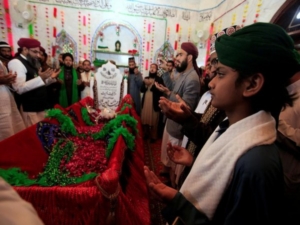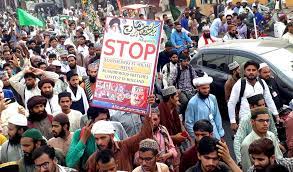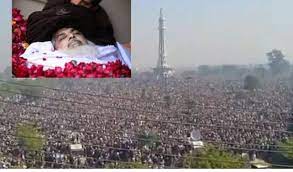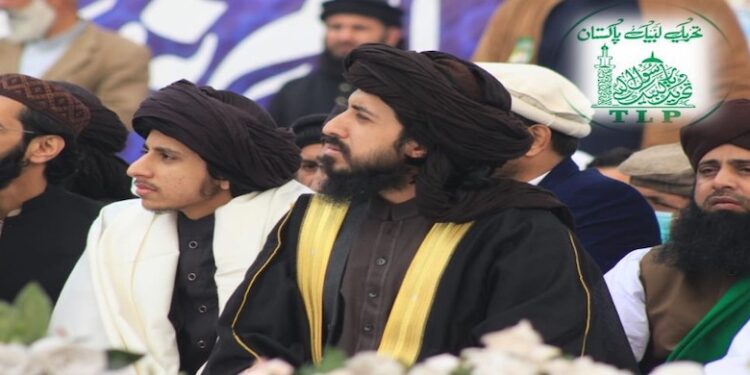Even without a wider platform or broad agenda to achieve victory in the polls, groups such as TLP are poised to exploit the grievances of the general public
Many Pakistanis – and the world at large – have been wondering how a religious group has been agitating for the expulsion of the French Ambassador from the country, on account of ‘blasphemous’ cartoons that were published and disseminated in France, and which were not banned by the French government due to its secularist stance on freedom of expression.
The origin, rapid rise and popularity of Tehreek-i-Labbaik Pakistan (TLP) is intertwined with the recent political history of Pakistan. The TLP, following the Barelvi subsect of Sunni Islam, is a movement to defend the honor of Islam’s Prophet and to uphold the belief in the “finality” of Prophethood- that Muhammad (PBUH) is the last Prophet. There is widespread support for the blasphemy laws that ironically were instituted by the British when they ruled the Indo-Pak subcontinent. TLP has not only emerged as the populist voice for punishing blasphemers, but it has successfully employed social media to garner more fame and deepen its street power.
While Sunni and Barelvi sentiments have been popular in Pakistan and South Asia, they have not turned overtly political until recent years. During the creation of Pakistan, Barelvi religious leaders played a significant role, but they largely remained a peaceful and pro-state group.
A liberal’s murder empowers the radicals
The recent turmoil erupted during the trial of a Police guard Mumtaz Qadri, who in January 2011 shot dead Salmaan Taseer, governor of the Punjab province, in broad daylight in Islamabad – presumably because Qadri believed speaking against the blasphemy law was itself blasphemy. Qadri’s supporters believe he was justified in killing Taseer because he had called for pardoning a Christian woman – Asia Bibi – convicted under blasphemy laws, the misuse of which he also condemned. As the murder trial proceeded, religious clerics including TLP’s co-founder and now deceased Khadim Rizvi flexed their muscles on the streets of Pakistan. Five years after Governor Taseer’s murder, Rizvi led a major rally in Lahore. This protest was against the Supreme Court’s verdict that confirmed death sentence for Qadri. Some participants at the January 2016 rally waved decorative swords, demanding Qadri be released.
While Sunni and Barelvi sentiments have been popular in Pakistan and South Asia, they have not turned overtly political until recent years.
However, Qadri was hanged as per the court’s landmark ruling in October 2011. Despite immense pressure, the then-government headed by former PM Nawaz Sharif did not relent.
March 2016 was a turning point in TLP’s fortunes as it mobilised Barelvis across the country, with hundreds of thousands attending Qadri’s funeral in the garrison town of Rawalpindi a few miles away from the federal capital. Many in the crowd were furious with the courts for convicting Qadri, with the then-prime minister Nawaz Sharif for not issuing a presidential pardon, and with the media for adhering to a strict news blackout on the protests.
The mammoth rally was organized under the banner of the Tehreek-i-Labbaik Ya Rasool Allah, a coalition of Barelvi groups including the most active Sunni Tehreek, led by Sarwat Ijaz Qadri. Others in the motley coalition included Aalmi Tanzeem Ahle Sunnat, led by Pir Muhammad Afzal Qadri, and the Fidayeen-i-Khatam-i-Nabuwat, led by Khadim Hussain Rizvi. Soon this coalition evolved from Tehreek-i-Labbaik Ya Rasool Allah into Tehreek-i-Labbaik Pakistan or the TLP. Though TLP was registered as an organization led by Khadim Rizvi in August 2015, it rose to prominence from its October 2017 sit-in at Faizabad.

A sectarian struggle for religious supremacy
TLP’s core following hails from the Barelvi sect, which represents a more syncretic and peaceable form of Islam derived from Sunni as well as Sufi doctrines. It emphasizes personal devotion to Allah and to Prophet Muhammad (PBUH), as well as veneration of saints: the latter being the reason why it has so many adherents in Punjab and Sindh, home to a plethora of shrines celebrating saints from all ages for their services to the propagation of Islam in the subcontinent.
More importantly, Barelvi Islam was deemed in the 21st century as a potent antidote for the stricter literalist creed of the Deobandi sect, whose followers include the leadership as well as rank and file members of terror groups such as Taliban, Lashkar-e-Jhangvi, Sipah-e-Sahaba, and an assortment of other violent extremist organizations. For this reason, the Barelvi organisation Sunni Ittehad Council (SIC) received $36,607 from the US government as a one-time grant in 2009 to organize anti-Taliban rallies. However, even the US embassy was shocked when the SIC demonstrated in favour of Mumtaz Qadri.
Since the 1980s, state patronage for Deobandi groups and proliferation of madrassas created sectarian divisions across Pakistan that have now aggravated into sociopolitical faultlines. Armed militias of hardline Deobandi factions set about imposing their beliefs on the rest of the Pakistani populace, violently suppressing all opposition to them from Barelvi, Ahl-e-Hadith, and even the Shi’a sects. In response, Barelvi groups established the ‘Sunni Tehreek’ in 1990 to counter Deobandi influence, and during the 1990s and 2000s both groups clashed violently with each other over different interpretations of Islam, as well as over control of mosques.
Naturally, when Deobandi extremists began sympathising with the Taliban, an alliance of eight Barelvi groups formed the SIC in 2009, organised anti-Taliban rallies and Barelvi ulema issued fatwas against suicide bombings and terrorism. One prominent example is Mufti Sarfaraz Naeemi, who issued a fatwa against suicide bombing – and was himself assassinated by a suicide bomber in 2009, becoming the latest Barelvi cleric to be killed by a Deobandi. Taliban-affiliated terrorists also frequently targeted shrines of saints revered by Barelvis: the 2010 and 2019 attacks on the Data Darbar shrine in Lahore, the 2010 attack on the Abdullah Shah Ghazi shrine in Karachi, and the 2009 attack on the Rehman Baba shrine in Peshawar, to name a few.
Since the 1980s, state patronage for Deobandi groups and proliferation of madrassas created sectarian divisions across Pakistan that have now aggravated into sociopolitical faultlines.
Just as the state allowed Deobandi hardliners to evolve into violent extremist groups in the first place, it created more space when it shifted its policy to avoid pariah status during the War on Terror, inadvertently letting militant groups with trained terrorists loose on the region. The state abandoned and disavowed them, and could no longer control them even if it wanted to. And while it appears easy to categorise Deobandis as extremist and Barelvis as moderate, the reality is never as stark. After witnessing the power and prestige that Deobandi groups enjoyed under state tutelage for decades, the Barelvi groups gravitated towards the state – for survival and sustenance if not patronage and sponsorship. And as the state evicted Deobandi groups from their perch of prominence, the Barelvis reorganised their numerical majority to counterbalance Deobandi influence, and in the process accumulated power in the domain of religious politics.
The public mobilisations of TLP – organic and spontaneous – since 2016 were a natural outcome of the realignment keenly noted by the security wings of the state as well as the civilian political sphere.
Religious beliefs, public pressure and political conspiracy
Civilian regimes in Pakistan remain weak and, almost always, end up in conflictual situations with the country’s powerful establishment. This was no different for the former PM Nawaz Sharif who had been ousted by the military twice; and in his third term (2013-2017) history repeated itself as a farce. Sharif was disqualified and ousted by the Supreme Court of Pakistan for not declaring a small ‘receivable’ income. But Sharif’s party, Pakistan Muslim League-Nawaz (PML-N), remained popular, and it was not feasible to carry out full-scale regime change. His successor Shahid Khaqan Abbasi steered the government until the summer of 2018 when new elections were held.
In November 2017, TLP staged a 21-day dharna (Faizabad sit-in) that culminated in the government capitulating to the group’s demands. The main demand of TLP was the resignation of the Law Minister over amendments to the Khatm-e-Nabuwwat clause in Election Act 2017. When the PM wanted to crackdown the idea was rejected as law enforcement personnel were wary of facing the wrath of clerics and appearing as anti-faith. But it was more problematic than that. Sections of the state were encouraging the sit-in and public protests. A final agreement between the government and the TLP was brokered by the security establishment. A senior military officer signed it as a guarantor. At the end of the sit-in, videos and images of officials distributing cash as return fare to their ‘brothers’ went viral. A Supreme Court bench took notice of these developments and issued a scathing judgment also criticized the media that kowtowed to the whims of the government or to the emotions of the masses, rather than upholding the law and enjoining others to follow it as well.
The PTI (which later came into power in 2018 elections), used the TLP’s 2017 mobilisation as an opportunity to gain political mileage, as is the custom in Pakistani politics. PTI chief Imran Khan even acknowledged that his party workers wanted to join the protesters.
TLP was registered as a political party and notified as such by the Election Commission of Pakistan on May 25, 2017. This was a time to translate its street power into votes at the ballot box, emerging as one of the largest parties in the country. Rizvi made international headlines as his party won over 2 million votes (taking about 4% of the total votes cast) in the 2018 general elections. “Anecdotal evidence showed that in many seats, TLP votes pushed PML-N to second position, one reason for the loss of PML-N seats,” the Gallup survey said. This buttressed the rise of PTI to victory in the 2018 polls, as it not only wrested PML-N’s Barelvi vote from them, but also prevented them from campaigning effectively as their candidates were given anti-religious labels by TLP. Former Interior minister Ahsan Iqbal was shot by a TLP sympathiser. Luckily, Iqbal survived the attack.
More significantly, in 2018 elections, TLP also outperformed the established religious-political parties such as the Muttahida Majlis-e-Amal, receiving five times more votes than the latter in Punjab. Despite this surprising performance, however, TLP was not able to secure a single National Assembly seat: analysts theorize that this is because TLP had emotional appeal on just one issue, and did not combine it with an overarching social and economic agenda. The greatest defeat was that of the liberal PPP which trailed behind TLP in most constituencies of the Punjab province. TLP also managed to secure assembly seats in the Sindh province and had a strong showing in Lyari, a bastion of PPP for decades.
This was a mainstreaming project, for until now it had been useful to its political engineering pursuits. This compact however was not going to last long.
More significantly, in 2018 elections, TLP also outperformed the established religious-political parties such as the Muttahida Majlis-e-Amal, receiving five times more votes than the latter in Punjab.
TLP turns against its benefactors
A series of protests by TLP were held immediately after reports emerged – the blasphemy accused Asia Bibi was going to be freed by the courts and subsequently be allowed to leave the country. Asia Bibi was acquitted by the Supreme Court on October 31, 2018, and TLP was back on the streets, once again using the Asia Bibi case as a lightning rod to rally its base.
Once again, the government acquiesced to the demands of the group, owing to its sit-ins bringing the nation to a crippling standstill. Another agreement was signed with the TLP on November 2 to end their protests, with Noor-ul-Haq Qadri, the religious affairs minister, representing the federal government. Asia was barred from leaving the country and the arrested protesters were freed. A review petition challenging her acquittal was heard by the court.
When the petition was quashed, Asia was quickly transferred from her jail in Multan to Nur Khan airbase on November 7, where she flew to the Netherlands on a chartered plane. The manner of her departure suggests that she was flown out of the country ostensibly under the advice and pressure of Western countries, especially the European Union.
Khadim Rizvi and others, now emboldened, issued derogatory remarks against the chief justice and the leadership of Pakistan’s armed forces, encouraging their supporters to kill the former and launch a rebellion against the latter. Rizvi and other far-right religious leaders were arrested in the aftermath of these protests, but were subsequently released in May 2019.
The Frankenstein effect was already clear.
No turning back from the streets
In September 2020, the TLP was again protesting on the streets, this time rallying its base over cartoons mocking Prophet (PBUH), which were republished in France. Rallies were held across Pakistan, including Karachi, Rawalpindi, Peshawar, Lahore and Dera Ismail Khan.

Similar rallies held in Pakistan earlier in 2015 had turned violent: scores were injured as police clashed with protesters trying to make their way to the French consulate in Karachi. Pakistan’s government also condemned the reprinting of the cartoons. Charlie Hebdo has long tested the limits of what society will accept in the name of free speech; unfortunately, it has now become the raison d’être for TLP’s public support and political power. In 2012, the authorities had also banned YouTube in September of that year after an anti-Islamic film mocking the Holy Prophet (PBUH) was hosted on its platform. Islamabad remained under siege for a day and the then-PPP government had also capitulated.
In November 2020, the group occupied Faizabad junction connecting Islamabad to Rawalpindi, prompting another round of talks. Another agreement was signed. This time the government promised to raise the issue of the French ambassador’s expulsion in Parliament within three months, and agreed once more to release TLP workers. The government did not officially confirm the agreement, but the interior ministry issued a notification regarding immediate release of all arrested TLP supporters.
The holy son: TLP leadership after Rizvi’s demise
When Khadim Rizvi passed away due to COVID-19 a few days after the November 2020 protest, and his son was appointed as the new leader, many believed this was the end of the TLP as a force to be reckoned with: they would be proven wrong in short order.
First, the funeral of Rizvi in Lahore was an eye-opener as thousands flocked to pay their last respects in defiance of a ban on public gatherings due to the ongoing pandemic. Videos of the funeral crowd resurfaced in April 2021 as Twitter users exploited the visuals to demonstrate conflict in Pakistan’. Second, the taste of street power was too seductive for the successors of Rizvi. They did not have to wait for an international scandal or a court judgment: all they had to do was to exploit the religious emotions of the populace by exclaiming that Islam was in danger, and that only they could save Pakistan from an unidentified but ubiquitous bogeyman, i.e. the West. For instance, Khadim Rizvi had made the argument that Islam was under threat from the West publishing sacrilegious cartoons, and he threatened to nuke Holland and France to prevent them from blaspheming. If he or his followers ever heard of ‘Veteran TV’, their protests would have opened up yet another Pandora’s Box for US-Pakistan relations.

Yet another agreement
In February 2021, the government signed a new agreement with TLP after the group threatened fresh protests due to perceived inaction on the previous deal. The new agreement promised to put the question of expelling the French ambassador to Pakistan, as well as other issues, for a decision by Parliament before April 20.
On April 12, more protests erupted after the arrest of the new TLP chief, Saad Rizvi. The preemptive action was taken after indications that TLP would yet again take to the streets in order to force the government into honoring the agreement signed in November, 2020.
Instead of arresting the imminent threat, Saad Rizvi’s arrest only ignited the tinderbox. Leaderless TLP workers were seen on the streets of major cities in Punjab and Sindh, wielding sticks and attempting to block roads – in stark contravention of COVID SOPs and guidelines. The protests escalated into violent clashes with the police, forcing the government to proscribe TLP under provisions of the 1997 Anti-Terrorism Act. On April 16, the government blocked social media for 4 hours as it launched a security operation to arrest all TLP troublemakers on the streets. While the state decided to ban the TLP and label it a terrorist organization on April 16; within 24 hours however, the same government was negotiating with TLP to end the protests.
TLP’s power had once again been demonstrated. Clashes with protesters resulted in the death of 7 policemen and injuries to at more than 800: six policemen died during the rioting while the seventh, constable Dilbar Hussain, succumbed to his injured on May 4, 2021. TLP also abducted nearly a dozen policemen from Nawan Kot police station and subjected them to torture. To add insult to grave injury, the parliamentarians offered prayers for the TLP workers who died in the protests they themselves started, but forgot to pray for the policemen who perished in the line of duty.

On April 20, TLP supporters at the last remaining protest site – a mosque run by TLP in Lahore’s Yateem Khana Chowk area – dispersed after it was announced that, as per a newly negotiated agreement with the government, a resolution for expulsion of the French ambassador had been tabled in Parliament. However, on April 23, the parliamentary session was prorogued for an indefinite period, without passage of the resolution. The mainstream political parties, not to be left behind, also endorsed the TLP narrative and attempted to present themselves flag-bearers of Khatm-e-Nabuwwat during the parliamentary session. They pointed out loopholes and procedural lacunae in tabling of the resolution, and started protesting on the assembly floor when question hour was given precedence over discussion on the resolution. The political parties playing to the gallery were eager to demonstrate who was a better defender of faith and the Prophet (PBUH).
Clashes with protesters resulted in the death of 7 policemen and injuries to at more than 800: six policemen died during the rioting while the seventh, constable Dilbar Hussain, succumbed to his injured on May 4, 2021.
TLP decided to challenge the ban in the courts. Many in the country opposed the blanket ban as it fanned TLP narrative, while others question the effectiveness of this move, as other political parties and extremist groups had been banned in the past, only to re-emerge under a different name. After the April 2021 rioting, Deobandi religious leaders were seen jumping on the TLP bandwagon for the first time. Mufti Muneeb called for a one-day general strike, which was supported by Maulana Fazl-ur-Rehman. While they openly objected to the ban and the arrests, it is more likely that they would seek to secretly hijack TLP’s narratives in order to accrue its public relevance, street power and vote bank.
Convergence of all sects on the dignity, honor and finality of Prophet Muhammad (PBUH) makes the Khatm-e-Nabuwwat issue a powerful political tool for mass mobilization. Similarly, the notion of blasphemy is easy to exploit to rile the sentiments against the blasphemer – whether such an accusation is credible or not, is beside the point for many Pakistani Muslims.
TLP’s growing support base includes the youth
TLP’s followers, unlike other religious groups, are not solely drawn from madrassah students or clerics. Young men from different walks of life were seen in street protests and were active in the commission of violence. Clearly, class disparities and economic inequalities are at play. More than half of Pakistan’s youth is illiterate or unskilled to gain employment.
In the absence of basic scholastic training and critical thinking skills, the country’s youth bulge is stuck in a vicious cycle of unquestioning obedience to those who appear to be authorities of religious knowledge, and have been trained to respond with a misplaced self-righteousness when faulty notions and conspiracy theories considered ‘universal truths’ are challenged with reason. Unfortunately, this lack of patience and inability to accommodate alternative or opposing viewpoints is itself the first phase of extremism.
Pakistan needs a GDP growth rate of more than 7% to accommodate millions that enter labor force. But the economy has been consistently shrinking and class divisions are profound. TLP workers’ anger against businesses, state officials, public infrastructure and private property is indicative of the frustration with the status quo which is only going to increase if Pakistan does not achieve political and economic stability. Public investments in education and vocational training have also shriveled in the recent past; and in any case, these have historically been far lower than regional countries such as Bangladesh and India. It is not easy to prove any causality between the two factors but given the gradual decline of ideological politics and mainstream political parties wedded to neoliberal policies, it is not difficult to surmise that groups like TLP might grow into attractive alternatives in the future.
Multidimensional and often contradictory forces of globalisation are manipulated by elements like TLP to suit their own narratives. The injuries, perceived or real, rendered by the West to the imagined monolith of the ‘Muslim Ummah’, and global Islamophobia in response to the scourge of Islamist terrorism, also plays into the hands of those who seek to divide us from others as well as from within.
Contemporary Pakistan is a fertile ground for TLP’s rejectionist politics; especially of an economic system based on dependence on Western (and of late, Chinese) capital. For instance, Rizvi in one of his speeches said that we need not repay loans as Muslims don’t pay interest. When asked what how the country’s economy would survive if we default on our international obligations, the response is replete with threats of exercising military power.

TLP’s support base also includes a variety of trader-merchant classes who finance its operations, viewing as a means of expressing piety. Despite the ban that the government imposed, TLP contested a recent by-election in Karachi and secured 10,688 votes, coming in third place behind PPP and PML-N but surpassing the ruling PTI. Its voters in Karachi’s poorer neighborhoods and among the Memon (business) community have been growing over the recent years.
TLP will become stronger especially because it no longer requires its original leaders to command its cadres during the violent protests and exhibitionism of street power. All it requires is a firebrand to hijack its core narrative, identify a conjured adversary, convolute a conspiracy, and present himself as the ‘savior of Islam’. While TLP has used the Khatm-e-Nabuwwat and blasphemy law narratives to paint Mumtaz Qadri as a hero, and Asia Bibi and France as the villains, it will not be long before the Barelvi desire for supremacy and disdain for other sects also becomes a central feature of its divisive politics and vicious protestations. After one of his speeches at the Badshahi mosque in Lahore, the late Khadim Rizvi was heard disparaging the call to prayer because, according to him, it was “a Wahabbi azaan”. In May 2020, TLP was reportedly involved in attacking a Shia procession in Karachi. Since they fail miserably in imparting a well-rounded education, Pakistan’s madrassas and their instructors are adept at propagating piety and dangerous supremacism over rival sects and non-Islamic faiths.
A state of many paradoxes
Throughout Pakistan’s history, its civil and military elites have employed religion as a means of nation building, political leveraging and a legitimizing force. At the same time, the postcolonial state also retains the Weberian aspirations of meritocratic and rational governance. However, in the recent decades such contradictions have become intense.
For instance, in recent years the successive governments have paid lip service to the constitutional obligation: that they will enforce its writ and not bend over to co-opt or concede to any violent radical group. Yet, their indecisive nature and the cynical use of religious groups for political purposes have continued. While the use of Deobandi-Salafi jihadism was required for regional security projects such as the Afghanistan jihad against the Soviet Union (aided by the United States and Saudi Arabia, among others), the fielding of majoritarian Barelvi power is a literal genie out of the bottle. TLP has tasted the success of imposing accords and conditions, and in a short period of time has also gained traction at the ballot box. Fascism is never a hurried project. Such groups enter the electoral arena and continue to expand their power. The examples from Germany, India, Brazil, more recently the United States, and many other countries are well known and need no reiteration here. Even without a wider platform or broad agenda to achieve victory in the polls, groups such as TLP are poised to exploit the grievances of the general public and blame them on the status quo: which, in Pakistan, is the ineffective, hypocritical and ‘anti-Islamic’ system of governance.
There are no easy solutions for a fragmented polity such as Pakistan. Cracking down on TLP will further its cause, and letting it function in hybrid democracy with disorganized political parties will only enhance TLP’s appeal. It is the time for the government especially the security establishment in Pakistan to seek inputs from civil society and look beyond the pool of in-house expertise.
First and foremost, Pakistan must return to a functional parliamentary democracy with civic spaces for an ideological countering of TLP’s divisive politics and hyper-emotional narrative. Second, there is no choice but to turn Pakistan into a developmental state, for its current security-centric and pan-Islamic identity project has run its course. Skills, jobs, and redistribution of power and wealth must replace the cartelisation and centralisation that defines the country. In this regard, the emphasis on geoeconomics by the current Army Chief is a step in the right direction. Finally, it is simply not enough to search for rational faith leaders or promote tolerant facets of Islam. Late Khadim Rizvi was successful in popularizing his interpretation that violence was an article of faith. This is why the ruling classes have to initiate reverse engineering by separating religion from the business of the state, from the education system, the Constitution, the laws and public narratives.
It might take a decade or two, but it has to begin now.
This article was originally published in The Friday Times on September 12, 2021



